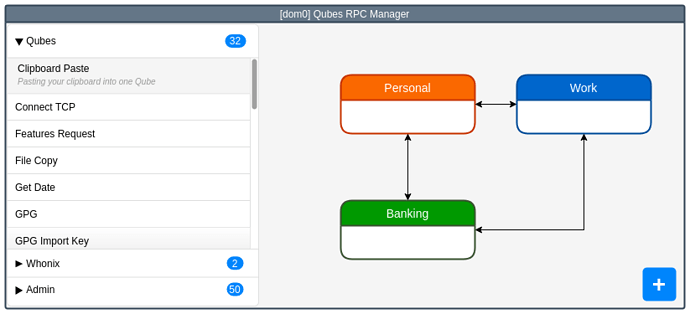The value a GUI would bring is easing the selection of source/target and not having to know specific Qubes-RPC syntax.
The other value a GUI would bring is turning those low-level Qubes-RPC policy files into a graphic that clearly shows the inter-VM access control that is currently being enforced.
YES. Exactly. The above is a basic premis of most control panels. 1 : “Let me modify settings to configure My Thing,” and 2: “Let me get a broader view of All My Things to see how those existing details are shaping my experience in this moment.”
That said… @deeplow’s mockup feels extremely detailed and shaped around features to serve a mental and informational model that is neither obvious nor intuitive to me. Which is not at all “a negative,” just many more steps ahead from where my brain is at right now, with seeking to build a thing that will be intuitive to all users (which yes, is entirely possible and important to strive for, with complicated domain-knowledge intensive stuff).
At the outset of tackling an entirely new realm of UI functionality, “Feature” level detail ideas of UI particulars feel more distracting then helpful for shaping the current need, which is developing an information and interaction model. Comments by @icequbes1 get more at what I’m looking for, but still feel theoretical.
If you all are comfortable telling me in this forum about policies y’all have set up on your own machines—and to tell me about those things in the format of “I have a policy prohibiting my Personal VM from copying files to my Work VM, my Banking VM, and all Template VMs, because I work with my most sensitive document there” that would help me the most. That format covers 1. What the rule is, 2. Origin VM, 3. Target VM, and 4. Motivation/Benefit behind why. Once I get a better sense of how everyone does their policies, I’ll be better poised to devise a UI.
Alternately, the team@research.qubes-os.org email has its encryption key on the Team page on the qubes website. If that kind of information is sensitive, I"d love if folks wouldn’t mind sending me those details for their own machines, there. THAT would help me, more than anything, tbh.


